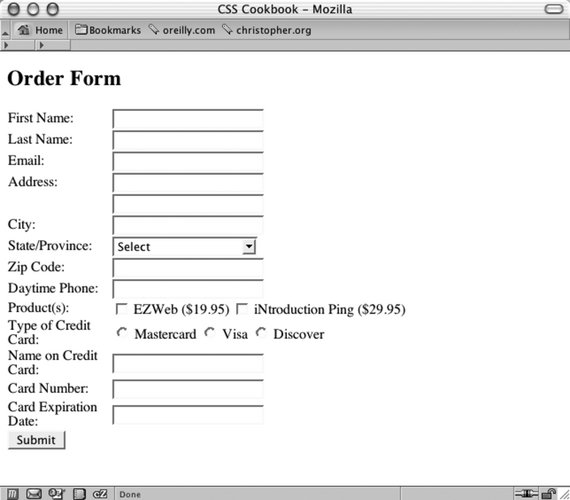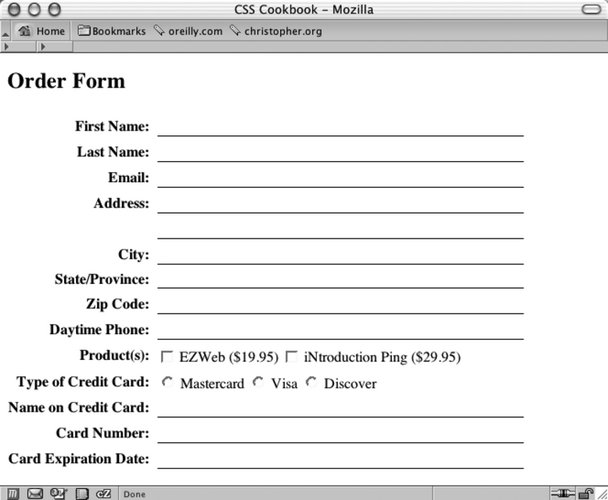Recipe 10.2. Making a Web Form Print-Ready
ProblemYou need to have a form that users can fill out online, or that they can print and then fill out offline, like the one in Figure 10-1. Figure 10-1. An online form SolutionFirst, create a print media style sheet and a class selector that transforms the form elements so that they display black text and feature a one-pixel border on the bottom. For example, the following HTML code for an input text element: <label for="fname">First Name</label> <input name="fname" type="text" /> requires the following CSS rule: <style type="text/css" media="print "> .fillout { color: black; border-width: 0; border: 1px solid #000; width: 300pt; } </style>For drop-down menus, hide the select element altogether and add some additional markup to help produce the bottom border: <label for="bitem">Breakfast Item</label> <select name="bitem" size="1"> <option selected="selected">Select</option> <option>Milk</option> <option>Eggs</option> <option>Orange Juice</option> <option>Newspaper</option> </select><span > </span> Then, in the CSS rules, convert the inline span element to a block element. This enables you to set the width of the span element and places the border at the bottom to equal that of the input elements in the preceding CSS rule: <style type="text/css" media="print"> select { display: none; } .postselect { display: block; width: 300pt; height: 1em; border: none; border-bottom: 1px solid #000; } </style>For elements such as a Submit button, which can't be used on the printed page, set the display property to none. You can see the finished product in Figure 10-2. Figure 10-2. The same form primed for printing DiscussionLines on an order form tell users they can fill out the form. By using the border property, you can easily create these lines in a browser, making web forms useful both online and offline. For select elements, the workaround is somewhat of a hack that involves interfering with the ideal semantic markup; it still works and is valid HTML. Place a span element after the select element: <select name="bitem" size="1"> <option selected="selected">Select</option> <option>Milk</option> <option>Eggs</option> <option>Orange Juice</option> <option>Newspaper</option> </select> <span > </span> Then set the select element to disappear: select { display: none; }Next, set the span element to display as a block to enable the width and height properties. With those width and height properties set, the bottom border can be placed to match the rest of the form elements: .postselect { display: block; width: 300pt; height: 1em; border: none; border-bottom: 1px solid #000; }Using attribute selectors to differentiate form elementsAs browsers implement attribute selectors from the CSS specification, styling forms for print becomes easier. Currently, the only browsers that support attribute selectors are Firefox, Netscape Navigator 6+, and Opera 5+. When you use attribute selectors, it's easier to distinguish which form elements should be stylized than it is when you insert class attributes and their respective values in the markup. In the following code, the first CSS rule applies only to input elements for text, while the second rule hides the Submit button and the Select drop box: input[type="text"] { color: black; border-width: 0; border: 1px solid #000; } input[type="submit"], select { display: none; }Adding user friendlinessSince the form is now being printed, site visitors cannot use the Submit button to transmit their information. Be sure to provide the next steps users should follow after they have printed and completed the form. For example, if you want users to mail the form, add a mailing address to the page on which the form is printed, as shown below: <div > <p>Please mail the form to the following address:</p> <address > <span > <span >The White House</span> </span><br /> <span >1600 Pennsylvania Avenue NW</span><br /> <span >Washington, DC</span> <span >20500</span><br /> <span >USA</span> </address> </div> Notice that the instructions are wrapped with a div element where the class attribute's value is set to print. In the style sheet for screen delivery, set the display property for this specific class to none: <style type="text/css" media="screen"> .print { display: none; } </style>With a separate style sheet for print delivery, allow the instructions to be printed by setting the display property to block: <style type="text/css" media="print"> .print { display: block; } </style>See AlsoAttribute selector documentation in the W3C specification at http://www.w3.org/TR/CSS21/selector.html#attribute-selectors; HTML 4.01 specification about the label tag at http://www.w3.org/TR/html401/interact/forms.html#edef-LABEL. |
EAN: 2147483647
Pages: 235